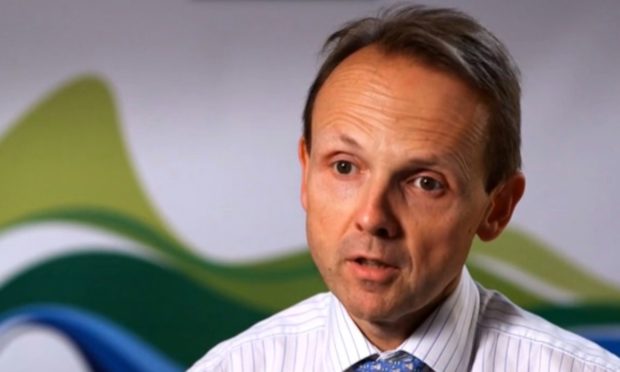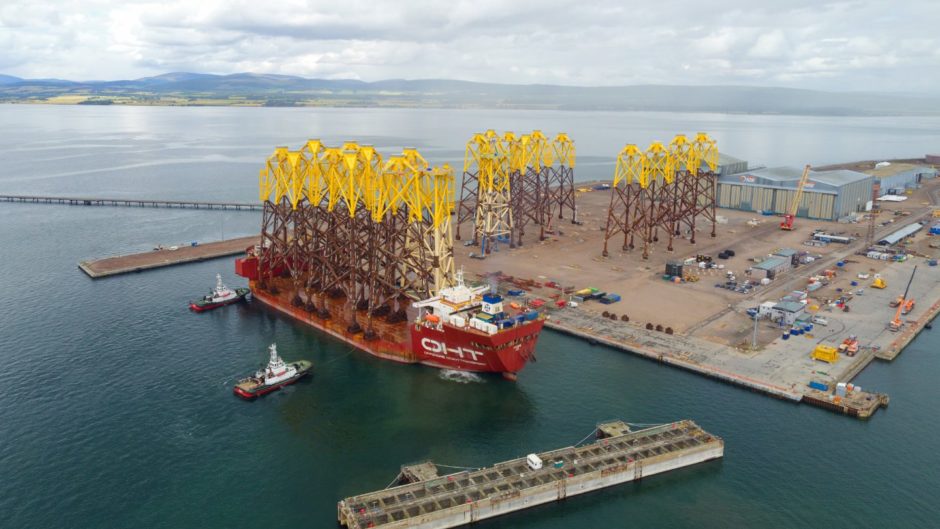SSE chief executive Alistair Phillips-Davies has outlined his confidence in a bigger domestic supply chain emerging alongside a fast-growing UK offshore wind energy industry.
Tying supply chain commitments to awards due to be made through the current ScotWind leasing round will help deliver onshore capacity to meet the needs of offshore developments, he said.
And likening the pace of change in the market to the birth of the North Sea oil and gas industry, he said he expected the offshore wind supply chain to develop in a similar way.
He added: “The UK should be able to build on its leadership position in offshore wind and develop capacity onshore, as happened with oil and gas. ”
SSE’s annual profits up 4% on an adjusted basis
Mr Alistair Phillips-Davies was speaking after Perth-based SSE announced a 4% jump in adjusted pre-tax profits to £1.06 billion for the year to March 31.
Statutory pre-tax profits rocketed by 328% to £2.5bn on revenue that was flat at £6.8bn.
The group’s renewables arm teamed up with Japanese conglomerate Marubeni Corporation and Danish fund management company Copenhagen Infrastructure Partners to submit joint bids for the ScotWind seabed leasing process, managed by Crown Estate Scotland.
SSE Renewables already has the largest offshore wind portfolio in Scotland and has been involved in the industry from early-stage demonstration projects through to developing, constructing and operating Scotland’s current largest offshore wind farm, Beatrice.
As part of joint ventures, the firm is also leading the construction of the 1.1 gigawatt (GW) Seagreen project, off Angus, and Dogger Bank, which at 3.6GW will be the largest offshore wind farm in the world.
Port of Nigg already capturing some supply chain business
SSE Renewables and project partner Total recently chose Global Energy Group’s Port of Nigg, near Inverness, as the marshalling, storage and logistics base for 114 wind turbine foundation structures destined for the £3bn Seagreen development.
SSE plans to invest around £2bn, largely in low carbon power projects, this year and is weighing up further investments as Scotland prepares to host the COP26 climate summit.
The group’s current year spend is part of a £7.5bn investment plan to 2025, which includes £2.8bn to connecting huge swathes of new renewable power and transport it via the electricity transmission system.
SSE aims to ramp up renewable development to reach a run rate of at least 1GW of new assets a year during the second half of the decade.
Export opportunities
The company is also seeking new opportunities to export its renewables and engineering expertise to other countries, with Mr Phillips-Davies citing Denmark, Spain, Portugal, the US and Japan as areas of interest.
SSE expects to kick-start a sale process for all of its 33% stake in gas network operator SGN, including Scottish Gas Networks, mid-summer and hopes to see this concluded before the end of 2021.
Mr Phillips-Davies said: “The UK is leading the world in the decarbonisation agenda and SSE is powering that change.
“We want to keep the momentum up and ensure the economic recovery helps tackle the climate emergency too.
“This is a pivotal year for the planet in our fight against climate change and, as a principal partner of COP26, we are supporting the UK Government’s efforts to drive more urgent and ambitious climate action.”
He added: “At the same time we are focused on ensuring equitable social outcomes from the net-zero transition; and through our investment programme we are building projects that will not only help tackle climate change but will create green jobs and revitalise communities along the way.”
Alongside the renewable investments, SSE’s electricity transmission business is anticipating spending £2.8bn through to 2026 to connect more green power in the race to net-zero.
SSEN Transmission is planning an undersea “electricity superhighway” on the east coast to bring more renewable power from the wet and windy north of Scotland to centres of population.
It is also working on other potential opportunities to connect additional islands to the national grid, in order to unlock more renewable resources.
In addition, Mr Phillips-Davies highlighted the group’s ambitions to be at the heart of future hydrogen and carbon, capture and storage (CCS) projects around the UK.
SSE is working with Norwegian energy firm Equinor to develop plans for CCS facilities in Peterhead and the Humber region, as well as potentially the world’s first hydrogen power station.
As a principal partner of COP26, we are supporting the UK Government’s efforts to drive more urgent and ambitious climate action.”
Alistair Phillips-Davies, SSE chief executive
It is also exploring options to build Coire Glas, a huge, pumped storage hydro station near Loch Lochy, in Lochaber, that could power an estimated three million homes for up to 24 hours and act as a “natural battery for when the wind doesn’t blow and the sun doesn’t shine”.
Mr Phillips-Davies said: “We are a business with solutions to support decarbonisation across the economy, options to create value and, when combined with our operational expertise, we are in a strong place to deliver towards the net-zero challenge.”
Asked if he believed spending on new oil and gas projects should end immediately to combat global warming, as the International Energy Agency suggested in a recent report, SSE’s boss was non-committal but added: “Starting those debates is the right thing to do”.
SSE proposed a final dividend of 56.6p per share, making a full-year payment of 81p, with the company continuing to target increases in line with average annual retail price index inflation.
An analyst’s view
John Moore, senior investment manager at wealth manager Brewin Dolphin, said: “SSE has been re-shaping its business in recent years, positioning itself flexibly within renewable energy and strengthening its balance sheet with the disposal of non-core assets.
“The company is the largest issuer of green bonds in the FTSE and has a range of sustainability-based investment opportunities – it is an exciting time for an operator of scale in this evolving area.
“The key debate, however, is the level of dividend payment. While investors may be pleased to see the RPI-linked increase and have the certainty of a dividend path until 2023, there is an argument that SSE should be paying a lower dividend after this date and investing more to benefit from the changing energy environment.”
New energy boom on the horizon for north-east

